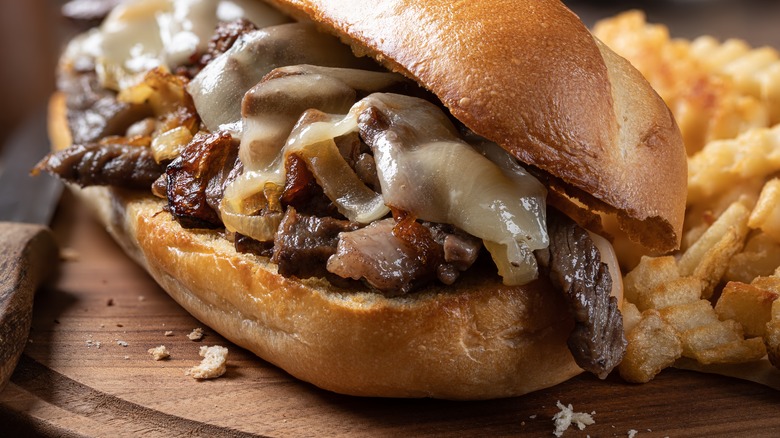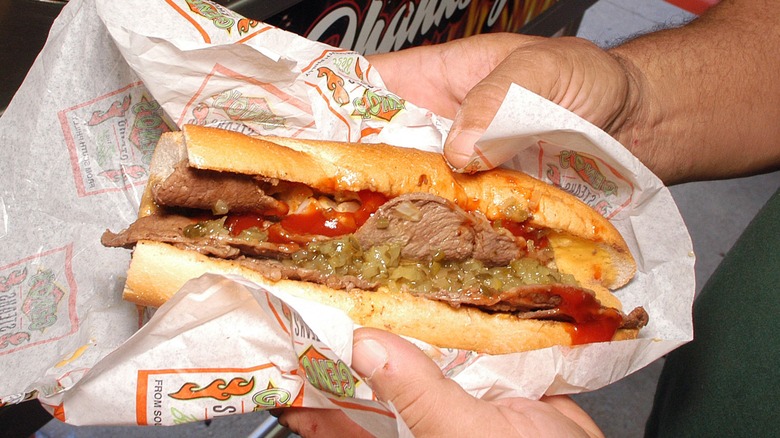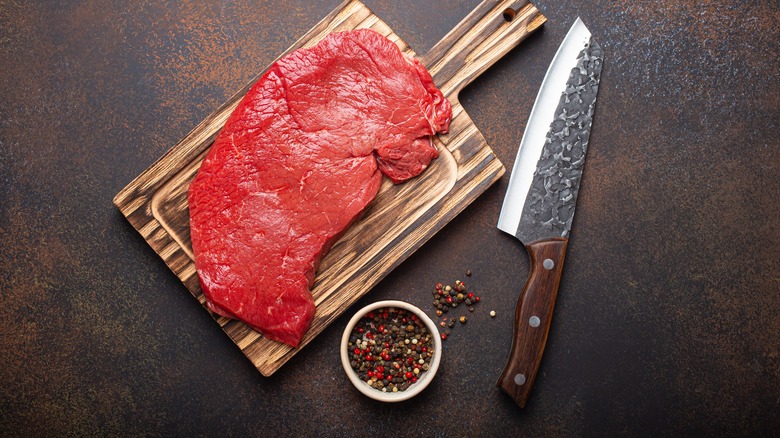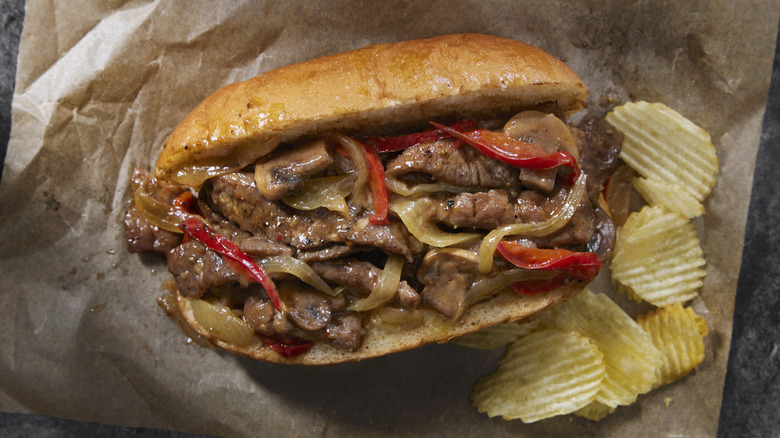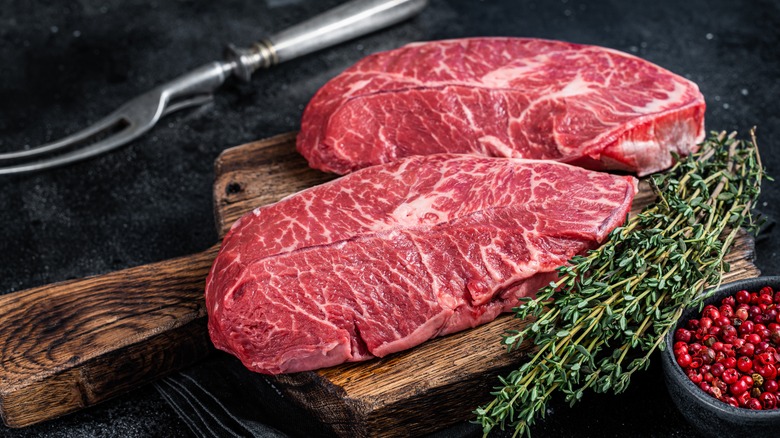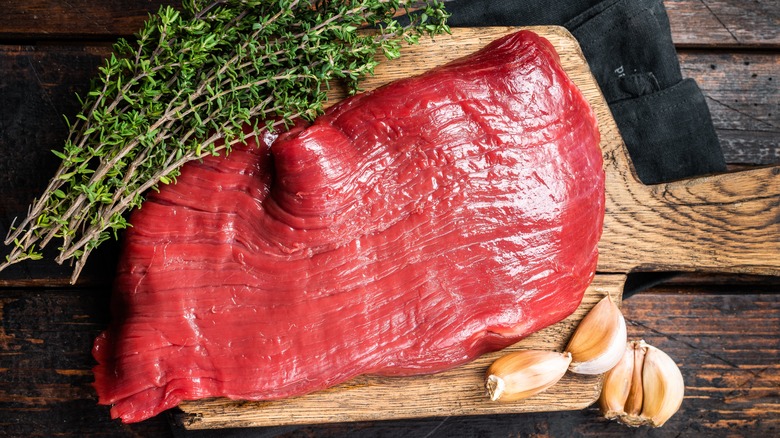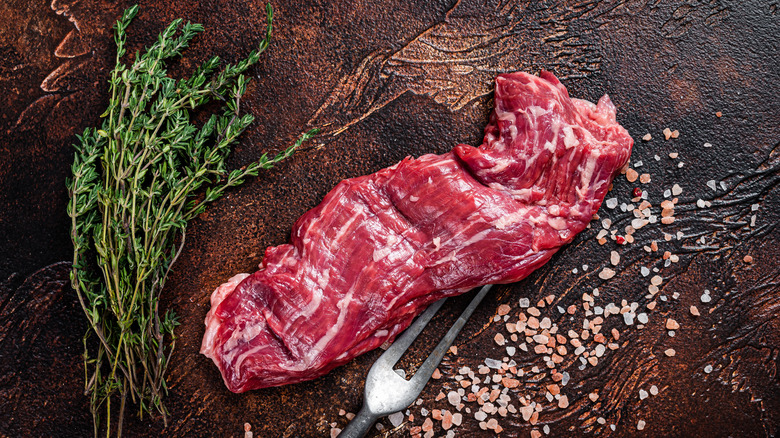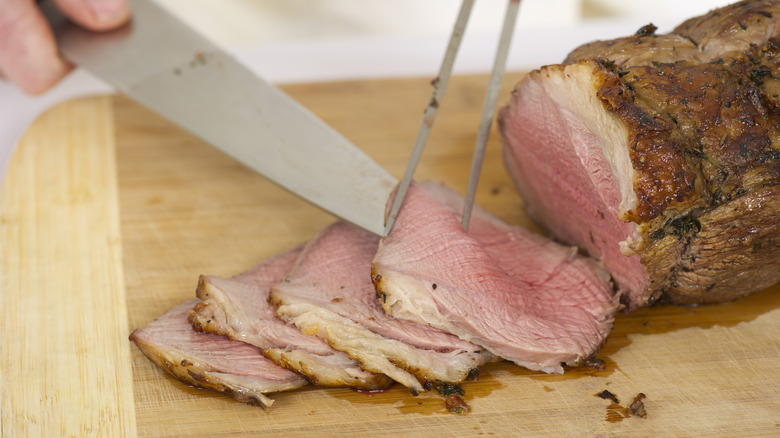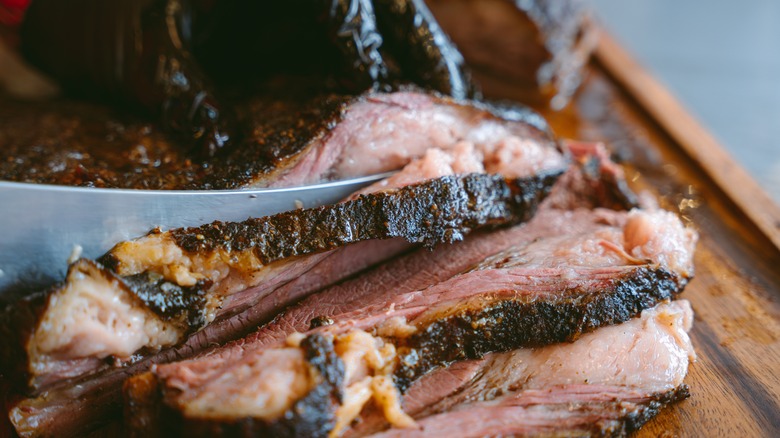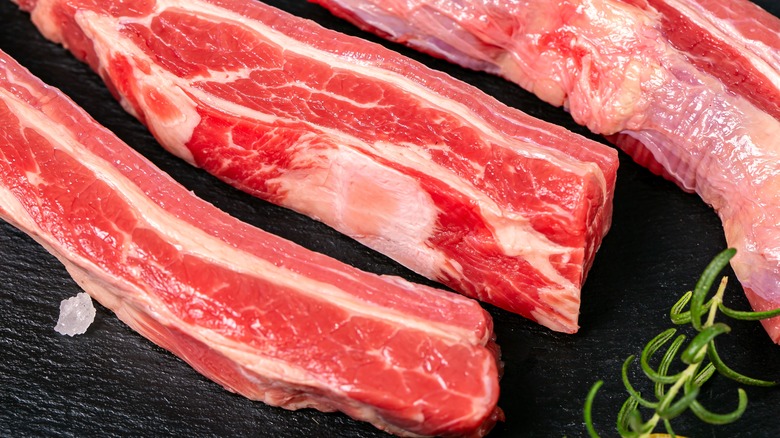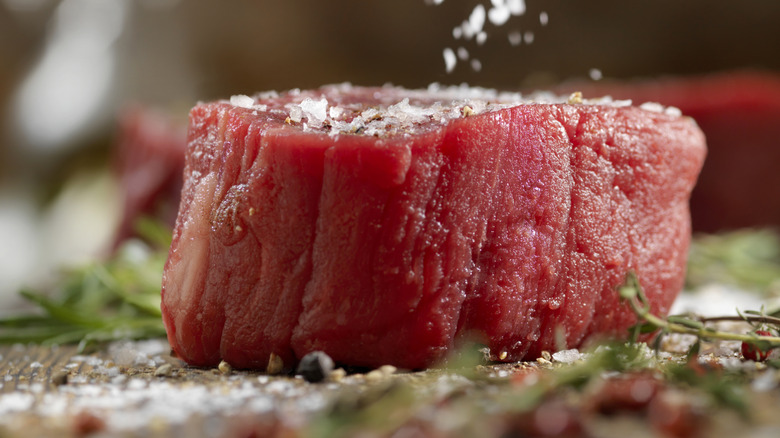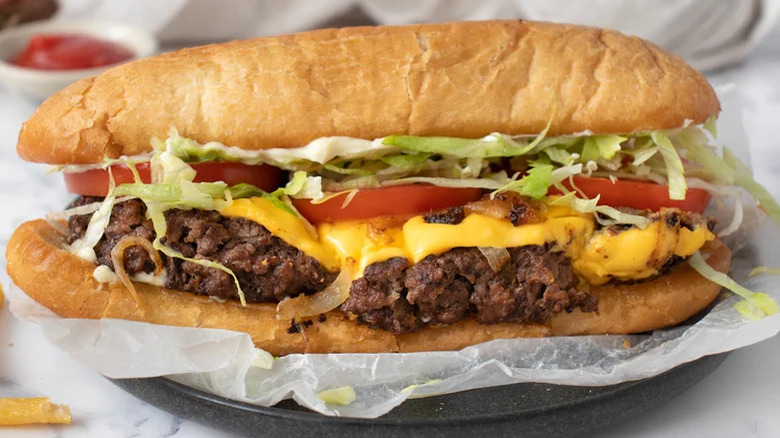8 Best And 3 Worst Cuts Of Beef For Cheesesteak, According To Chefs
A great Philly cheesesteak is a work of art. The very best and most authentic of these savory sandwiches follow a fairly strict formula of thinly sliced steak paired with melted cheese sauce on a long roll, with many people choosing sautéed onions as the secret ingredient for a Philly cheesesteak. And many people have strong opinions about each and every element of this sandwich.
While many Philadelphians prefer cheddar-style cheese sauce, white American or provolone cheeses are considered as acceptable. Toppings may include ketchup, mushrooms, mayo, or peppers. Chef Ryan Ratino of Michelin-starred Bresca in Washington, D.C. adds that "the correct bread is also unbelievably important, a soft hoagie roll," he says.
But no element of the sandwich is as important as the beef. For Ratino, it should be well-marbled, and according to Dana Ehrlich, founder of Verde Farms — a leading U.S. provider of 100% grass-fed organic beef — thinly slicing it is paramount. And while some cheesesteak traditionalists insist that only one cut is allowed, others are a bit more flexible.
For Ryan Leonard, regional executive chef at American Social, "I would argue that any cut of steak could produce a mighty fine cheesesteak provided it is treated right." This might mean tenderizing tougher cuts or even slow-cooking them. "The best cheesesteak comes from a great leftover steak," he adds. That said, some cuts are indeed better than others for cheesesteak. Here are the ones our experts love — and the ones they eschew.
Best: Ribeye
We could begin and end this article here. Ribeye is undoubtedly the most popular cut for the absolute best cheesesteaks, and it's not hard to see why. Richly marbled and thus deeply flavorful, ribeye isn't just "the most classic cut of steak" for cheesesteaks due to tradition, according to Ryan Leonard. "Ribeye ranks high on the list for me due to its tenderness, rich flavor, and ratio of fat and meat."
Dana Ehrlich agrees, noting that the fat content of ribeye makes it "juicy, flavorful, and filling." And what's more, he says that despite the expensive nature of ribeye, you don't necessarily need to shell out. Ehrlich says that insiders often use lower-quality ribeye grades for cheesesteak sandwiches, something that you don't necessarily notice given the way in which it's traditionally prepared.
"Usually the ribeyes are pre-sliced very thin before cooking so they can be placed directly on the griddle, cooked very quickly, and then chopped into smaller bits before being placed into the hoagie roll," Ehrlich says.
Best: Top round
While ribeye may be the most traditional cut for a Philly cheesesteak, it's far from your only option. According to Ratino, top round is another common choice, and Ehrlich echoes this assertion, noting that people often choose top round to cut costs. Indeed, top round typically retails for under $6 per pound, as compared to around $9 a pound for ribeye.
But while top round may be a common option, for Ehrlich, going for the cheaper choice isn't necessarily a good idea. "I find this cut less flavorful and tender," he says. And that makes sense. Top round hails from the inner hind leg of the cow, and it's leaner than some other cuts like ribeye. Texturally, top round can be on the tougher side, and it also has a milder flavor and less juicy texture than ribeye. That said, once you add all the accoutrements, it can still shine in a cheesesteak, especially if you're looking to spend a bit less.
Best: Sirloin
Another cut that beef experts like for Philly cheesesteaks is sirloin, which is leaner than ribeye. Ryan Leonard recommends sirloin "for those who are a bit more adventurous," noting that this cut "can surprise you" if prepared correctly.
A good marinade can help add flavor and tenderize the steak, especially one made with acidic ingredients like mustard or balsamic vinegar. Using acid in a marinade helps to break down the proteins, softening the texture of chewier cuts. But be sure not to marinate the steak for too long: After more than a few hours, the effects of the marinade can ruin the beef.
Sirloin can also benefit from added flavor. Cooking the steak in bacon grease adds smoke and fattiness — both of which are welcome for leaner sirloin — and you could even smoke the sirloin for next-level deliciousness. You could also split the difference by choosing Wagyu sirloin, which has more marbling than your run-of-the-mill cut and thus provides even richer flavor.
Best: Flat iron
Tender and marbled flat iron steak is a relatively recent offering in butcher's cases — up until recently, this cut never would have been served as a steak. Thanks to university researchers, it's now possible to use precise butchering techniques to divest this piece of steak from the sinew that ordinarily makes flat iron so chewy. As a result, these days this tender, deeply flavored cut is a bit more commonplace — and it's a delicious choice for Philly cheesesteaks.
Hailing from the shoulder, flat iron steak has deep, rich flavor and decent marbling, especially when compared to some other cuts on this list. Many beef professionals consider flat iron as the second-most tender steak on the whole animal, only a little less soft than filet mignon. For Leonard, flat iron can be a surprising change-up from ribeye thanks to its richness, especially when sliced "super thin." And seeing as flat iron is sourced from the chuck primal, it's relatively inexpensive, making this cut the best of both worlds.
Best: Flank steak
Naturally leaner than most other cuts of beef, flank steak may be a bit of a controversial addition to this list, but trust us: This cut deserves a second look. Hailing from the abdominal area of the cow, flank steak can be pretty tough, but it's also intensely flavorful — and when thinly sliced, as for cheesesteak, it makes a delicious sandwich filling.
To slice your flank steak as thinly as possible, first freeze it for about 20 minutes. Use a very sharp knife, and be sure to slice it against the grain, in the same direction of the muscle fibers running through the meat. This will reduce the meat's chewiness. While you can certainly add fat to increase the flavor and richness of this steak, you can also enjoy it as is to reduce the overall fat content of the dish, relying instead on the toppings to add more flavor.
Best: Skirt steak
Skirt steak is long, lean, and tough — in many ways similar to flank steak. But while flank steak comes from the abdomen, skirt steak comes from the diaphragm, which lends it a slightly more fibrous texture ... and a bit more fat and flavor intensity. For these reasons, skirt steak can be a great option for cheesesteak — particularly if it's marinated.
Another option when working with skirt steak is to change up the form of the cheesesteak itself. Why not transform flank steak into cheesesteak pinwheels? Making a pinwheel skirt steak isn't difficult; it just requires arranging the ingredients — in this case sautéed onions, cheese, and steak seasoning — on the raw, trimmed skirt steak. Roll it tightly and tie it off with butcher's twine before tossing it on the grill or under the broiler. The resulting pinwheels may not be traditional, but they're certainly an impressive, lower-carb alternative to a classic cheesesteak.
Best: Roast beef
If you're strapped for time, deli roast beef can make a quick and tasty cheesesteak base. Since the beef is already cooked and thinly sliced, all you need to do is quickly prepare your toppings and assemble the sandwich, using the broiler to heat the meat through and melt the cheese.
You can also make your own roast beef at home to use in Philly cheesesteaks and other sandwiches. While many consider a leaner cut of roast beef (such as a top loin roast) to be the best for sandwiches, any leftover roast beef would be pretty happy in a cheesesteak. The next time you're making beef roast for a dinner party or holiday, consider cooking more than you need and saving the leftovers so that Philly cheesesteaks will be within your reach for days. (And for that matter, save any leftover gravy for enjoying sandwiches French dip style.)
Best: Brisket
Our beef experts are divided as to whether brisket makes a good cheesesteak filling. This tougher cut from the cow's breast is too full of connective tissue to be cooked like a ribeye, according to Ryan Leonard, but with the right added steps, it can make a delicious, inexpensive base for a Philly cheesesteak.
"Tougher cuts might require an initial preparation to ensure it is tender," Leonard says, "but oftentimes, this can lend to a better yield at a better cost."
Brisket's tough texture means it's usually slow-cooked by braising or smoking, which melts the collagen and ensures that it's tender and flavorful. Leonard says that any tough cut treated in this fashion — from brisket to short rib to oxtails — can "provide a great finished product."
"Despite being a Philly traditionalist," echoes Ryan Ratino, "there has been a lot of innovation in the cheesesteak space. If we can use mushrooms, Beyond Beef, or seitan, I don't see any reason why [brisket] wouldn't work."
Worst: Brisket
While some experts are in favor of giving braised brisket cheesesteaks a try, others say that the techniques required to tenderize brisket before it can be an enjoyable sandwich filling precludes this cut from being a true example of Philadelphia's most famous dish.
"Braised beef could work from an eating experience," says Dana Ehrlich of this suggestion, "but it would not be considered a Philly cheesesteak by a local."
And if you're not braising the brisket, don't bother. While these cuts are ultra-flavorful and a pure pleasure to eat after slow-cooking, the connective tissue and collagen that can lends so much flavor when allowed to melt slowly make brisket as chewy as bubblegum when it's cooked quickly over high heat, like a traditional ribeye. This holds for other cuts with loads of connective tissue, like chuck roast (which comes from the shoulder) or shank, which is sourced from the lower leg.
Worst: Filet mignon
While filet mignon could be delicious in a cheesesteak, it wouldn't be putting this tender cut to its best advantage. Filet mignon is known for its lean, buttery texture and mild, very subtle flavor. Best when charred on the outside and rare on the inside, its major selling point is its tenderness.
Slicing filet mignon as thinly as you'd need to make a traditional cheesesteak means that you'd lose out on most of its texture, putting its mild-mannered flavor center-stage. Hidden beneath cheese, onions, and other toppings, filet mignon is ultimately wasted when used in a cheesesteak. And considering the fact that this cut is among the most expensive steaks in any butcher case, that's a particularly unfortunate waste.
That said, Pat LaFrieda's filet mignon steak sandwich recipe is a delectable play on a Philly cheesesteak. He uses this tender cut by keeping the steak in thicker slices, and forgoing soft hoagie bread to instead pile the beef on more robust baguettes, which add a bit more texture to the resulting sandwich while standing up to the jus. This is not a traditional cheesesteak by any means, but it is an upscale play on the classic sandwich that's sure to be a crowd-pleaser ... provided you're not serving any Philly traditionalists.
Worst: Ground beef
While a ground beef cheesesteak could be a delicious iteration of a Philly cheesesteak, similarly to using brisket or filet mignon, traditionalists would probably find that it deviates too much from the original recipe to be worth the change.
"Ground beef could work as an alternative from an eating perspective, especially in a Philly cheesesteak-inspired pasta dish, for example," muses Dana Ehrlich, "but nobody in Philadelphia would invite you back if the core cheesesteak recipe was changed."
This is particularly true, according to Ryan Ratino, because a ground beef cheesesteak version already exists ... and it ain't from Philly. "That would be a chopped cheese," he says of the Big Apple's classic sandwich. "I'm sure New Yorkers would take exception to that being called a cheesesteak."
A chopped cheese, also known as a chop cheese, is typically prepared a bit differently than a cheesesteak, with adobo seasoning and onions added to the beef while American cheese slices are melted on top. Mayo, ketchup, lettuce, and tomato finish off this tasty sandwich. By using melted cheese sauce instead of American slices, and perhaps adding a few mushrooms and peppers, you might be able to nudge this sandwich into cheesesteak territory ... but then you might earn enemies in both New York and Philadelphia!
Static Media owns and operates Mashed and Food Republic.
